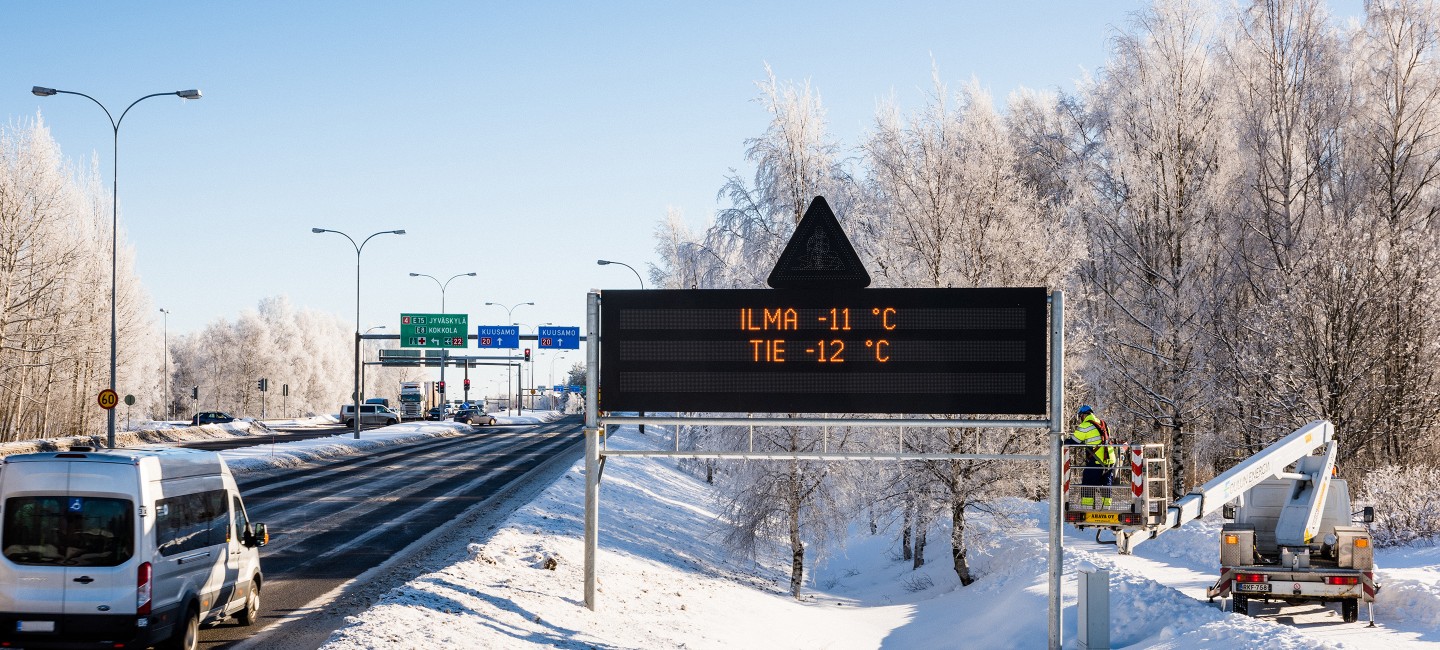Developing technology creates safe, efficient transport

You drive up to a quiet intersection and notice how the lights go from yellow to green. In the commuter traffic of the afternoon, the same lights balance out the queues of cars in every direction, perhaps making you wait for a bit. On the motorway, you notice a warning sign telling you there has been an accident ahead of you and you know to slow down even before you see the blinking lights of the emergency vehicles in the distance. While we usually take these advanced systems for granted in our day-to-day lives, they play a crucial role in the efficiency and safety of the entire traffic network as well as the surrounding areas.
One of the leading builders and maintainers of road telematics in Finland, Destia is in charge of the about 300 intersections with traffic lights in regions such as Oulu, North Ostrobothnia, Vaasa and Kainuu as well as all of the variable message signs and signaling systems in Northern Finland. However, telematics services are not limited to maintenance and repairs; Destia is strongly involved in developing traffic solutions that support the efficiency and safety of transport.
“We use the data available on transport and traffic and help develop the functionalities of various systems. We already have large quantities of measured data on how various solutions work. We participate in various local work groups aiming to use the collected data to make transport and traffic even more efficient and safe, both in cities and on the roads. Ultimately, the client decides the changes and measures to be carried out in a specific area and we then perform the practical implementation,” says Mikko Rasi, Business Unit Director for Telematics at Destia.
Destia joins the development of the HALI system
Traffic lights are one of the most common yet one of the most important factors in ensuring efficient traffic. They are optimised according to the needs of their environment. The work groups use traffic data to support their decision-making process regarding the placement and local optimisation of traffic lights.
Destia is also involved in the development of the traffic light priorities for emergency vehicles system HALI. The system is a fully automated traffic light priorities system that automatically turns traffic lights green when a vehicle on an emergency call approaches a controlled junction.
“The basic idea is that the system creates a green wave suited to the traffic environment for approaching emergency vehicles, while the systems installed in the vehicles transmit location, speed and direction data to the systems. At the moment, HALI covers about 700 junctions with traffic lights, and of course, the future goal is to cover all of Finland. The system enables fast and, above all else, safe traffic for both bystanders and those in the emergency vehicle,” says Rasi.
Real-time guidance offers valuable extra seconds for drivers
At their best, variable message signs can give drivers some extremely valuable time to react to accidents or unusual road conditions, for example. Signs often also offer instructions for avoiding risks and ensuring efficient traffic, allowing road users to adjust their actions accordingly. In normal conditions, road users can also be offered up-to-date information on the temperature, for example, or any construction sites in the area. In cities, variable message signs can be used for various purposes, such as guiding traffic during events.
“In the Oulu region, the signaling system is so advanced that it can direct traffic to a predetermined alternate route if the motorway is blocked due to an accident, for example. The systems interact with each other, making adjustments to the signs and traffic lights of the alternate route so that it can accommodate the sudden influx of traffic,” says Rasi.
Aiming for adaptable, safe traffic
Traffic lights, variable message signs, speed limits and informative displays are all important in ensuring safe, efficient traffic, but automated control also plays a significant role. Destia imports and services new automated control systems and instructs clients on the best placement of the cameras and the viability of the technical implementation. The placement of the cameras is based on various accident statistics provided by the authorities.
Ultimately, all technological traffic control systems aim for more efficient traffic that is safe for everyone. The current information is continuously supplemented by data from various systems and statistics, and new technology enables increasingly efficient service capability for changing needs. Efficient traffic also plays a vitally important role in the future of the environment; the less fluctuation in the speed of motor vehicles, the less direct emissions they produce.
“Our goal is for the traffic system to adapt and consider the variables of traffic, quickly and purposefully. The benefits are indisputable; not only for cities or authorities but for all road users. We’ve come a long way, and we’ll keep working for even further progress,” says Rasi.
